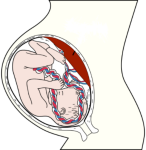Fetal position (position of the baby in the maternal pelvis) at the onset of labour is one of the greatest determining factors of how the birth process will proceed. The optimal fetal position is pictured below. A good way to remember the best position is that if you can give your baby a back rub every time through your belly, then they are likely in a good position.
There’s lots you can do to affect the baby’s position. Read on!
The terms “posterior” or “sunny-side up” describe a baby who faces out, or is spine-to-spine with the pregnant woman. “OP” is the medical jargon, meaning occiput posterior. The part of the head that enters the pelvis is bigger in this position and the baby doesn’t flex and rotate as well as if they’re in the optimal position. That can make for a much longer, more painful and more complicated birth.
Problems Related to Posterior Position
- More difficult for baby to drop into and through the pelvis
- Pregnancy may last longer
- Membranes are more likely to rupture before the onset of labour
- Labour may progress slowly or not at all
- Back-labour – back-pain during labour that doesn’t disappear between contractions
- Increased risk of tearing
- Increased risk of instrumental (vacuum or forceps) or Caesarean birth
- Increased stress on baby’s head and nervous system
Some women birth a posterior baby just fine. Those include but are not limited to, women who’ve given birth without difficulty before, those with an average or smaller baby, a labouring woman who’s able to move about freely and allow her baby to rotate into an “anterior” (the optimal) position.
 Baby in optimal position: head down and flexed, back out.
Baby in optimal position: head down and flexed, back out.
Signs of a Posterior Baby
- Feeling kicks or flutters at the front
- Frequent urination (more frequent than with anterior pregnancy)
- Belly appears flat on top or lumpy
- Your midwife or doctor can tell by palpating your abdomen or by doing an ultrasound
- Fetal heart-tones may be difficult to hear
- Head is not engaged or doesn’t drop into pelvis
- Can be assessed during labour by a cervical check
Factors Contributing to Posterior Position
Babies can assume a posterior position with no risk factors, but the following increase the chances:
- North American lifestyle – reclining in upholstered furniture, sedentary lifestyle, sitting in cars (it’s interesting to note this position is rare in cultures where pregnant women walk a lot or work bent-over, and lack Lazy-Boy style chairs and couches)
- Sitting with legs crossed
- Postural or anatomical issues
- Issue of uterine / abdominal muscles (e.g. tight psoas)
- First pregnancy
- Epidural use early in labour (hinders rotation and descent of baby) is correlated with more than 3x the rate of posterior position at birth (Tully, 2008)
- Labouring in bed or without adequate movement
- Baby who was breech and turned to vertex (head down)
- Pregnant person with history of breech or posterior baby
- Short or tight cord around baby
- Emotional issues – fear of birth or parenting, not paying attention to pregnancy, family history of breech, relationship issues, financial concerns, stress (Frye, 1998)

Tricks for Turning a Posterior Baby to an Anterior Position
Sometimes there’s an unknown reason for the baby to be posterior and nothing will turn them. But in many cases a baby can be turned. Please ask for details or referrals.
- Visualization and “talking” to your baby. Focus on letting the baby know it’s easier to get out when facing the other way. This works especially well if combined with changing your emotional environment e.g. dealing with fears, prepping for birth.
- Look at a picture of baby in proper position (e.g. Fig. 1), or have it drawn on your belly!
- Webster Technique with a chiropractor certified in its use. Pistolese (2002) cites an 82% rate of success in relieving the musculoskeletal causes of intrauterine constraint. It’s beneficial to perform the Webster Technique starting at 35-36 weeks.
- Sit with pelvis tilted forward – knees below pelvis with straight back. Instead of upholstered furniture, use a birth ball, the floor, a kneeling chair or a regular hard chair or stool
- Hands and knees – read, crawl around, or do “child’s pose” modified for pregnant belly
- Pelvic rocking while on all 4’s – gentle “cats and dogs” yoga postures – several times daily
- Swimming or floating – anything with belly down like a hammock for baby to drop into
- Movement and exercise
- Sleep on left side with a body pillow – left leg straight, right leg bent on pillow
- Homeopathic Pulsatilla 200CH, 1 dose every 3 days.
- Acupuncture or moxibustion – see a Traditional Doctor of Chinese Medicine or an acupuncturist who specializes in women’s and pregnancy care.
- Deal with fears around childbirth and parenting
- Postural management – check out spinningbabies.com for some excellent postures and exercises that encourage babies to assume optimal positions for birth.
- Exercises to prepare for birth and encourage pelvic floor health, and optimal fetal positioning, such as the Miles Circuit.
